Akt2 Regulates the Differentiation and Function of NKT17 Cells via FoxO-1-ICOS Axis
- PMID: 30258434
- PMCID: PMC6143662
- DOI: 10.3389/fimmu.2018.01940
Akt2 Regulates the Differentiation and Function of NKT17 Cells via FoxO-1-ICOS Axis
Erratum in
-
Corrigendum: Akt2 Regulates the Differentiation and Function of NKT17 Cells via FoxO-1-ICOS Axis.Front Immunol. 2020 Sep 30;11:589346. doi: 10.3389/fimmu.2020.589346. eCollection 2020. Front Immunol. 2020. Retraction in: Front Immunol. 2021 Jun 14;12:716458. doi: 10.3389/fimmu.2021.716458. PMID: 33101321 Free PMC article. Retracted.
Retraction in
-
Retraction: Akt2 Regulates the Differentiation and Function of NKT17 Cells via FoxO-1-ICOS Axis.Front Immunol. 2021 Mar 31;12:686304. doi: 10.3389/fimmu.2021.686304. eCollection 2021. Front Immunol. 2021. PMID: 33868320 Free PMC article.
Abstract
As a critical linker between mTORC1 and mTORC2, Akt is important for the cell metabolism. The role of Akt in the function and development of B and T cells is well characterized, however, the role of Akt for development and function of iNKT cells is unknown. iNKT cells bridge the adaptive and innate immunity, and in this study, we found that the differentiation of NKT17 cells and IL17 production of NKT17 cells were disrupted in Akt2 KO mice. ICOS has been demonstrated to be critical for the differentiation of NKT17 cells and we found that ICOS mRNA and protein expression was reduced in Akt2 KO iNKT cells. As a consequence, phosphorylation of FoxO-1 was downregulated in Akt2 KO thymocytes but the sequestration of FoxO-1 in the nucleus of Akt2 KO iNKT cells was increased. The negative feedback loop between ICOS and FoxO-1 has been demonstrated in CD4+T follicular helper cells. Therefore our study has revealed a new intracellular mechanism in which Akt2 regulates ICOS expression via FoxO-1 and this signaling axis regulates the differentiation and function of NKT17 cells. This study provides a new linker between cell metabolism and function of iNKT cells.
Keywords: Akt2; FoxO-1; ICOS; NKT17; iNKT.
Figures
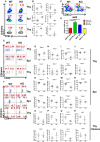
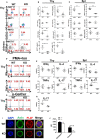
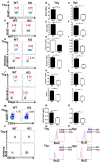
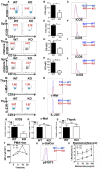
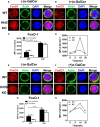
Similar articles
-
Corrigendum: Akt2 Regulates the Differentiation and Function of NKT17 Cells via FoxO-1-ICOS Axis.Front Immunol. 2020 Sep 30;11:589346. doi: 10.3389/fimmu.2020.589346. eCollection 2020. Front Immunol. 2020. Retraction in: Front Immunol. 2021 Jun 14;12:716458. doi: 10.3389/fimmu.2021.716458. PMID: 33101321 Free PMC article. Retracted.
-
Inducible costimulator facilitates T-dependent B cell activation by augmenting IL-4 translation.Mol Immunol. 2014 May;59(1):46-54. doi: 10.1016/j.molimm.2014.01.008. Epub 2014 Jan 31. Mol Immunol. 2014. PMID: 24486724
-
iNKT cells require TSC1 for terminal maturation and effector lineage fate decisions.J Clin Invest. 2014 Apr;124(4):1685-98. doi: 10.1172/JCI69780. Epub 2014 Mar 10. J Clin Invest. 2014. PMID: 24614103 Free PMC article.
-
Unveiling the regulation of NKT17 cell differentiation and function.Mol Immunol. 2019 Jan;105:55-61. doi: 10.1016/j.molimm.2018.11.013. Epub 2018 Nov 26. Mol Immunol. 2019. PMID: 30496977 Review.
-
Markers and makers of NKT17 cells.Exp Mol Med. 2023 Jun;55(6):1090-1098. doi: 10.1038/s12276-023-01015-y. Epub 2023 Jun 1. Exp Mol Med. 2023. PMID: 37258582 Free PMC article. Review.
Cited by
-
Diversity of arterial cell and phenotypic heterogeneity induced by high-fat and high-cholesterol diet.Front Cell Dev Biol. 2023 Feb 23;11:971091. doi: 10.3389/fcell.2023.971091. eCollection 2023. Front Cell Dev Biol. 2023. PMID: 36910156 Free PMC article.
-
Differential Control of iNKT Cell Effector Lineage Differentiation by the Forkhead Box Protein O1 (Foxo1) Transcription Factor.Front Immunol. 2019 Nov 21;10:2710. doi: 10.3389/fimmu.2019.02710. eCollection 2019. Front Immunol. 2019. PMID: 31824499 Free PMC article.
-
iNKT subsets differ in their developmental and functional requirements on Foxo1.Proc Natl Acad Sci U S A. 2021 Nov 16;118(46):e2105950118. doi: 10.1073/pnas.2105950118. Proc Natl Acad Sci U S A. 2021. PMID: 34772808 Free PMC article.
-
Hippo/Mst signaling coordinates cellular quiescence with terminal maturation in iNKT cell development and fate decisions.J Exp Med. 2020 Jun 1;217(6):e20191157. doi: 10.1084/jem.20191157. J Exp Med. 2020. PMID: 32289155 Free PMC article.
References
Publication types
MeSH terms
Substances
LinkOut - more resources
Full Text Sources
Other Literature Sources
Molecular Biology Databases
Research Materials
Miscellaneous

